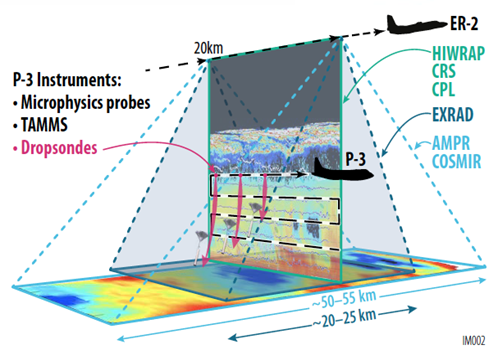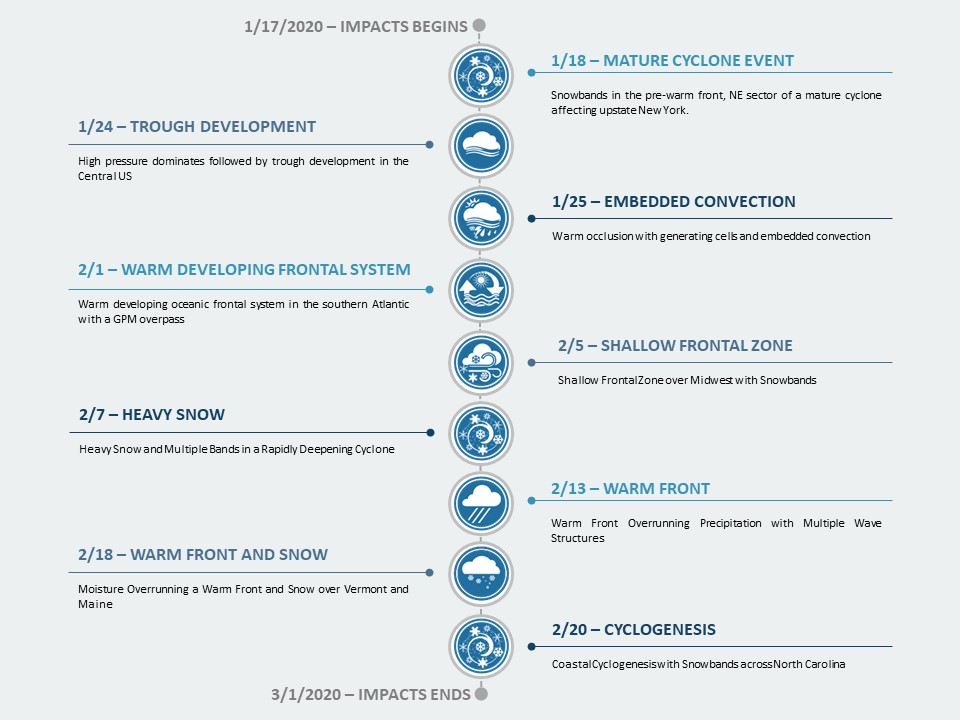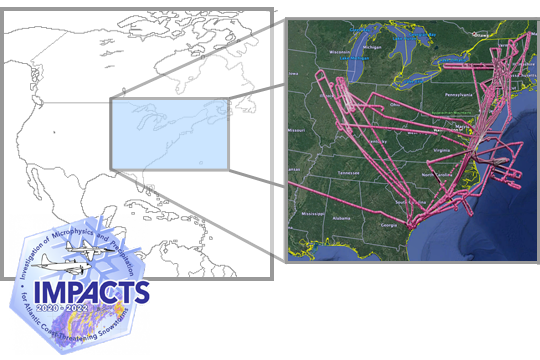Abdelmonem, A., Schnaiter, M., Amsler, P., Hesse, E., Meyer, J., and Leisner, T. (2011). First correlated measurements of the shape and light scattering properties of cloud particles using the new Particle Habit Imaging and Polar Scattering (PHIPS) probe, Atmos. Meas. Tech., 4, 2125–2142,
https://doi.org/10.5194/amt-4-2125-2011
Barrick, J. D. W., J. A. Ritter, C. E. Watson, M. W. Wynkoop, J. K. Quinn, and D. R. Norfolk (1996). Calibration of NASA turbulent air motion measurement system. NASA Tech. Pap. TP-310, NASA, Washington, D. C.,
https://ntrs.nasa.gov/archive/nasa/casi.ntrs.nasa.gov/19970010469.pdf
Battaglia, A., Mroz, K., Lang, T., Tridon, F., Tanelli, S., Tian, L., & Heymsfield, G. M. (2016). Using a multiwavelength suite of microwave instruments to investigate the microphysical structure of deep convective cores. J. Geophys. Res. Atmos., 121, 9356–9381,
https://doi.org/10.1002/2016JD025269
Faber, S, J.R. French, and R. Jackson (2018). Laboratory and in-flight evaluation of measurement uncertainties from a commercial Cloud Droplet Probe (CDP). Atmos. Meas. Tech., 11, 3645-3659,
https://doi.org/10.5194/amt-11-3645-2018
Field, P. R., A. J. Heymsfield, and A. Bansemer (2006). Shattering and particle interarrival times measured by optical array probes in ice clouds. J. Atmos. Ocean. Technol., 23, 1357–1371,
https://doi.org/10.1175/JTECH1922.1
Grecu M, L. Tian, G. M. Heymsfield, A. Tokay, W. S. Olson, A. J. Heymsfield, and A. Bansemer (2018). Non-parametric methodology to estimate snow from multiple frequency radar reflectivity observations. J. Appl. Meteor. Clim., 57 (11): 2605–2622,
https://doi.org/10.1175/JAMC-D-18-0036.1
Grecu, M., W. Olson, S. Munchak, S. Ringerud, L. Liao, Z. Haddad, B. Kelley, and S. McLaughlin (2016). The GPM combined algorithm. J. Atmos. Oceanic Tech., 33, 2225-2245,
https://doi.org/10.1175/JTECH-D-16-0019.1
Guimond, S.R., L. Tian, G.M. Heymsfield and S.J. Frasier (2014). Wind retrieval algorithms for the IWRAP and HIWRAP airborne Doppler radars with applications to hurricanes. J. Atmos. Oceanic Technol., 31, 1189-1215,
https://doi.org/10.1175/JTECH-D-13-00140.1
Gurganus, C. and Lawson, P. (2018). Laboratory and flight tests of 2D imaging probes: Toward a better understanding of instrument performance and the impact on archived data, J. Atmos. Ocean. Tech., 35, 7, 1533–1553,
https://doi.org/10.1175/JTECH-D-17-0202.1
Heymsfield, G. M., L. Tian, L. Li, M. McLinden, and J. I. Cervantes (2013). Airborne radar observations of severe hailstorms: Implications for future spaceborne radar. J. of Appl. Meteor. and Clim., 52, 1851-1867,
https://doi.org/10.1175/JAMC-D-12-0144.1
Heymsfield, G. M., S. Bidwell, I. J. Caylor, S. Ameen, S. Nicholson, W. Boncyk, L. Miller, D. Vandemark, P. E. Racette, and L. R. Dod (1996). The EDOP radar system on the high-altitude NASA ER-2 aircraft. J. Atmos. Oceanic Tech., 13, 795-809,
https://doi.org/10.1175/1520-0426(1996)013<0795:TERSOT>2.0.CO;2
Hlavka, D. L., J. E. Yorks, S. A. Young, M. A. Vaughan, R. E. Kuehn, M. J. McGill, and S. D. Rodier (2012). Airborne validation of cirrus cloud properties derived from CALIPSO lidar measurements: Optical properties, J. Geophys. Res., 117, D09207,
https://doi.org/10.1029/2011JD017053
Korolev, A. V., Kuznetsov, S. V., Makarov, Y. E., and Novikov, V. S. (2019) Evaluation of measurements of particle size and sample area. Atmos. Meas. Tech., 12, 3067–3079,
https://doi.org/10.5194/amt-12-3067-2019
Korolev, A.V., E.F. Emery, J.W. Strapp, S.G. Cober, and G.A. Isaac (2013). Quantification of the effects of shattering on airborne ice particle measurements. J. Atmos. Oceanic Technol., 30, 2527–2553,
https://doi.org/10.1175/JTECH-D-13-00115.1
Kroodsma, R. A., M. A. Fritts, J. F. Lucey, M. R. Schwaller, T. J. Ames, C. M. Cooke, and L. M. Hilliard (2019). CoSMIR performance during the GPM OLYMPEX campaign. IEEE Trans. Geosci. Remote Sens.,
https://doi.org/10.1109/TGRS.2019.2906039
Lance, S., Brock, C. A., Rogers, D., and Gordon, J. A. (2010). Water droplet calibration of the Cloud Droplet Probe (CDP) and in-flight performance in liquid, ice and mixed-phase clouds during ARCPAC. Atmos. Meas. Tech., 3, 1683–1706,
https://doi.org/10.5194/amt-3-1683-2010
Leppert, K. D., II, and D. J. Cecil (2015). Signatures of hydrometeor species from airborne passive microwave data for frequencies 10–183 GHz. J. Appl. Meteor. Climatol., 54, 1313–1334,
https://doi.org/10.1175/JAMC-D-14-0145.1
Li, L., G. Heymsfield, J. Carswell, D. Schaubert, M. McLinden, J. Creticos, M. Perrine, M. Coon, J. Cervantes, M. Vega, S. Guimond, L. Tian, and A. Emory (2016). The NASA High-Altitude Imaging Wind and Rain Airborne Profiler (HIWRAP). IEEE Trans. On Geosci. Remote Sens., 54, 298 - 310,
https://doi.org/10.1109/TGRS.2015.2456501
McFarquhar, G.M., D. Baumgardner, A. Bansemer, S.J. Abel, J. Crosier, J. French, P. Rosenberg, A. Korolev, A. Schwarzoenboeck, D. Leroy, J. Um, W. Wu, A.J. Heymsfield, C. Twohy, A. Detwiler, P. Field, A. Neumann, R. Cotton, D. Axisa, and J. Dong (2017). Processing of Ice Cloud In Situ Data Collected by Bulk Water, Scattering, and Imaging Probes: Fundamentals, Uncertainties, and Efforts toward Consistency. Meteor. Monographs, 58, 11.1–11.33,
https://doi.org/10.1175/AMSMONOGRAPHS-D-16-0007.1
McGill, M. J., M. A. Vaughan, C. R. Trepte, W. D. Hart, D. L. Hlavka, D. M. Winker, and R. Kuehn (2007). Airborne validation of spatial properties measured by the CALIPSO lidar. J. Geophys. Res., 112,
https://doi.org/10.1029/2007JD008768
McGill, M.J., L. Li, W.D. Hart, G.M. Heymsfield, D.L. Hlavka, P.E. Racette, L. Tian, M.A. Vaughan, and D.M. Winker (2004). Combined lidar-radar remote sensing: initial results from CRYSTALFACE. J. of Geophys. Res., 109,
https://doi.org/10.1029/2003JD004030
McGill, M.J., D.L. Hlavka, W.D. Hart, E.J. Welton, and J.R. Campbell (2003). Airborne lidar measurements of aerosol optical properties during SAFARI-2000. J. of Geophys. Res., 108, D002370,
https://doi.org/10.1029/2002JD002370
McGill, M. J., D. L. Hlavka, W. D. Hart, V. S. Scott, J. D. Spinhirne, and B. Schmid (2002). Cloud Physics Lidar: instrument description and initial measurement results. Appl. Optics, 41, 3725-3734,
https://doi.org/10.1364/AO.41.003725
McLinden, M., J. Carswell, L. Li, G. Heymsfield, A. Emory, J. Cervantes, and L. Tian (2013). Utilizing versatile transmission waveforms to mitigate pulse-compression range sidelobes with the HIWRAP Radar. IEEE Geosci. Remote Sens. Lett.,
https://doi.org/10.1109/LGRS.2013.2241729
Rosenberg, P. D., Dean, A. R., Williams, P. I., Dorsey, J. R., Minikin, A., Pickering, M. A., and Petzold, A. (2012). Particle sizing calibration with refractive index correction for light scattering optical particle counters and impacts upon PCASP and CDP data collected during the Fennec campaign. Atmos. Meas. Tech., 5, 1147-1163,
https://doi.org/10.5194/amt-5-1147-2012
Schnaiter, M., Järvinen, E., Abdelmonem, A., and Leisner, T. (2018). PHIPS-HALO: the airborne particle habit imaging and polar scattering probe – Part 2: Characterization and first results. Atmos. Meas. Tech., 11, 341–357,
https://doi.org/10.5194/amt-11-341-2018
Sippel, J. A., F. Zhang, Y. Weng, L. Tian, G. M. Heymsfield, and S. A. Braun (2014). Ensemble Kalman filter assimilation of HIWRAP observations of Hurricane Karl (2010) from the unmanned Global Hawk aircraft. Mon. Wea. Rev., 142, 4559-4580,
https://doi.org/10.1175/MWR-D-14-00042.1
Spencer, R.W., R.E. Hood, F.J. Lafontaine, E.A. Smith, R. Platt, J. Galliano, V.L. Griffin, and E. Lobl (1994). High-Resolution Imaging of Rain Systems with the Advanced Microwave Precipitation Radiometer. J. Atmos. Oceanic Technol., 11, 849–857,
https://doi.org/10.1175/1520-0426(1994)011<0849:HRIORS>2.0.CO;2
Thornhill, K. L., B. E. Anderson, J. D. W. Barrick, D. R. Bagwell, R. Friesen, and D. H. Lenschow (2003). Air motion intercomparison flights during Transport and Chemical Evolution in the Pacific (TRACE-P)/ACE-ASIA. J. Geophys. Res., 108(D20), 9001,
https://doi.org/10.1029/2002JD003108
Tian, L., G.M. Heymsfield, A.C. Didlake, Jr., S.R. Guimond, and L. Li (2015). Velocity-azimuth display analysis of Doppler velocity for HIWRAP. J. Appl. Meteor., 54, 1792 - 1808,
https://doi.org/10.1175/JAMC-D-14-0054.1
Wang, J. R., P. E. Racette, J. R. E. Piepmeier, B. Monosmith and W. Manning (2007). Airborne CoSMIR observations between 50 and 183 GHz over snow-covered Sierra Mountains. IEEE Trans. on Geosci. and Remote Sens., 45, 55-61,
https://doi.org/10.1109/TGRS.2006.885410
Wang, J. R, G. M Skofronick-Jackson, M. R. Schwaller, C. M. Johnson, W. B. Monosmith, and Z. Zhang (2013). Observations of storm signatures by the recently modified conical scanning millimeter-wave imaging radiometer. IEEE Trans. Geosci. Remote Sens, 51(1), 411-424,
https://doi.org/10.1109/TGRS.2012.2200690
Yorks, J. E., D. L. Hlavka, M. A. Vaughan, M. J. McGill, W. D. Hart, S. Rodier, and R. Kuehn (2011a). Airborne validation of cirrus cloud properties derived from CALIPSO lidar measurements: Spatial properties. J. Geophys. Res., 116, D19207,
https://doi.org/10.1029/2011JD015942
Yorks, J. E., M. McGill, D. Hlavka and W. Hart (2011b). Statistics of Cloud Optical Properties from Airborne Lidar Measurements. J. Atmos. Oceanic Technol., 28, 869-883,
https://doi.org/10.1175/2011JTECHA1507.1











